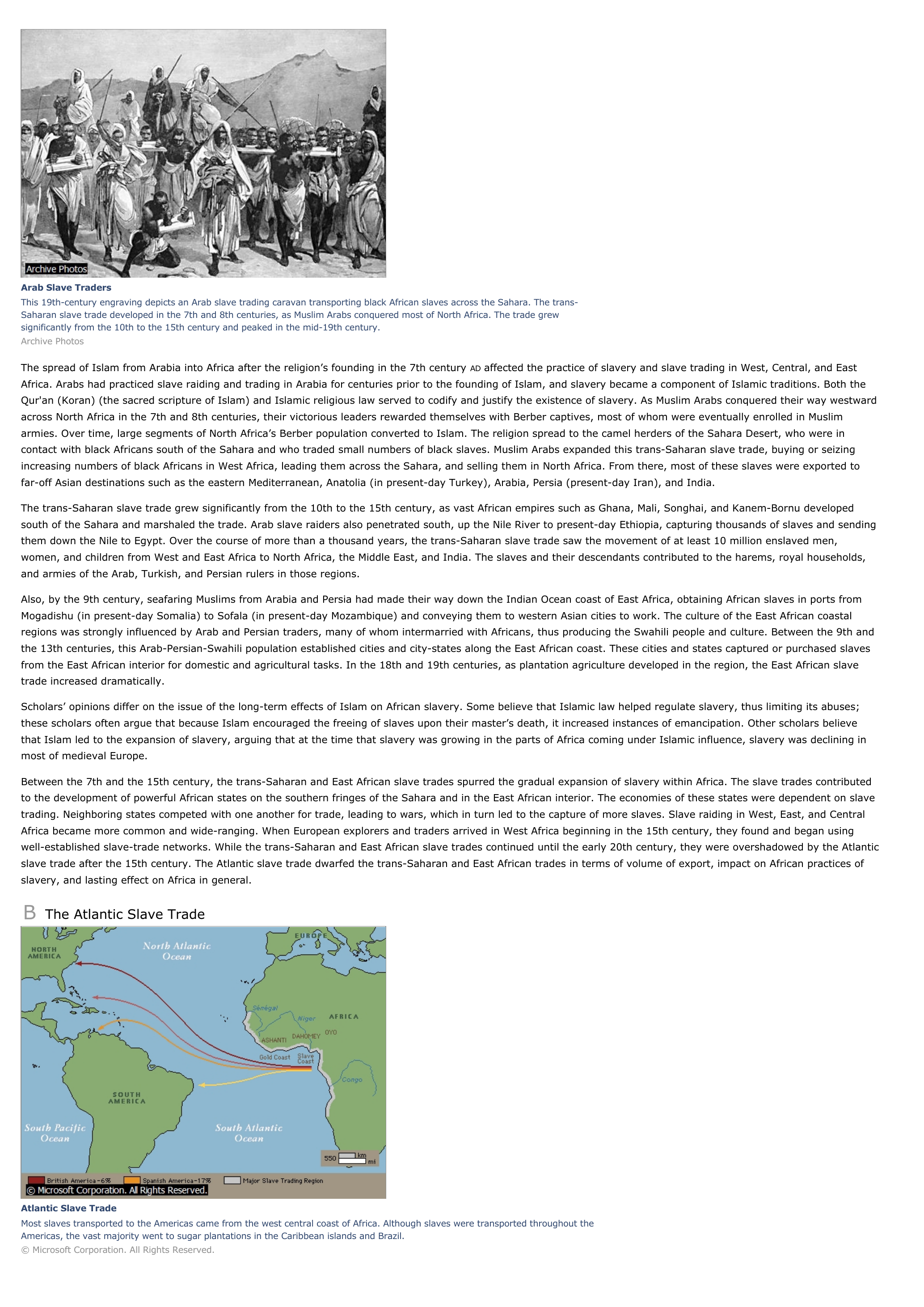Slavery in Africa - history.
Publié le 26/05/2013

Extrait du document
«
Arab Slave TradersThis 19th-century engraving depicts an Arab slave trading caravan transporting black African slaves across the Sahara.
The trans-Saharan slave trade developed in the 7th and 8th centuries, as Muslim Arabs conquered most of North Africa.
The trade grewsignificantly from the 10th to the 15th century and peaked in the mid-19th century.Archive Photos
The spread of Islam from Arabia into Africa after the religion’s founding in the 7th century AD affected the practice of slavery and slave trading in West, Central, and East Africa.
Arabs had practiced slave raiding and trading in Arabia for centuries prior to the founding of Islam, and slavery became a component of Islamic traditions.
Both theQur'an (Koran) (the sacred scripture of Islam) and Islamic religious law served to codify and justify the existence of slavery.
As Muslim Arabs conquered their way westwardacross North Africa in the 7th and 8th centuries, their victorious leaders rewarded themselves with Berber captives, most of whom were eventually enrolled in Muslimarmies.
Over time, large segments of North Africa’s Berber population converted to Islam.
The religion spread to the camel herders of the Sahara Desert, who were incontact with black Africans south of the Sahara and who traded small numbers of black slaves.
Muslim Arabs expanded this trans-Saharan slave trade, buying or seizingincreasing numbers of black Africans in West Africa, leading them across the Sahara, and selling them in North Africa.
From there, most of these slaves were exported tofar-off Asian destinations such as the eastern Mediterranean, Anatolia (in present-day Turkey), Arabia, Persia (present-day Iran), and India.
The trans-Saharan slave trade grew significantly from the 10th to the 15th century, as vast African empires such as Ghana, Mali, Songhai, and Kanem-Bornu developedsouth of the Sahara and marshaled the trade.
Arab slave raiders also penetrated south, up the Nile River to present-day Ethiopia, capturing thousands of slaves and sendingthem down the Nile to Egypt.
Over the course of more than a thousand years, the trans-Saharan slave trade saw the movement of at least 10 million enslaved men,women, and children from West and East Africa to North Africa, the Middle East, and India.
The slaves and their descendants contributed to the harems, royal households,and armies of the Arab, Turkish, and Persian rulers in those regions.
Also, by the 9th century, seafaring Muslims from Arabia and Persia had made their way down the Indian Ocean coast of East Africa, obtaining African slaves in ports fromMogadishu (in present-day Somalia) to Sofala (in present-day Mozambique) and conveying them to western Asian cities to work.
The culture of the East African coastalregions was strongly influenced by Arab and Persian traders, many of whom intermarried with Africans, thus producing the Swahili people and culture.
Between the 9th andthe 13th centuries, this Arab-Persian-Swahili population established cities and city-states along the East African coast.
These cities and states captured or purchased slavesfrom the East African interior for domestic and agricultural tasks.
In the 18th and 19th centuries, as plantation agriculture developed in the region, the East African slavetrade increased dramatically.
Scholars’ opinions differ on the issue of the long-term effects of Islam on African slavery.
Some believe that Islamic law helped regulate slavery, thus limiting its abuses;these scholars often argue that because Islam encouraged the freeing of slaves upon their master’s death, it increased instances of emancipation.
Other scholars believethat Islam led to the expansion of slavery, arguing that at the time that slavery was growing in the parts of Africa coming under Islamic influence, slavery was declining inmost of medieval Europe.
Between the 7th and the 15th century, the trans-Saharan and East African slave trades spurred the gradual expansion of slavery within Africa.
The slave trades contributedto the development of powerful African states on the southern fringes of the Sahara and in the East African interior.
The economies of these states were dependent on slavetrading.
Neighboring states competed with one another for trade, leading to wars, which in turn led to the capture of more slaves.
Slave raiding in West, East, and CentralAfrica became more common and wide-ranging.
When European explorers and traders arrived in West Africa beginning in the 15th century, they found and began usingwell-established slave-trade networks.
While the trans-Saharan and East African slave trades continued until the early 20th century, they were overshadowed by the Atlanticslave trade after the 15th century.
The Atlantic slave trade dwarfed the trans-Saharan and East African trades in terms of volume of export, impact on African practices ofslavery, and lasting effect on Africa in general.
B The Atlantic Slave Trade
Atlantic Slave TradeMost slaves transported to the Americas came from the west central coast of Africa.
Although slaves were transported throughout theAmericas, the vast majority went to sugar plantations in the Caribbean islands and Brazil.© Microsoft Corporation.
All Rights Reserved..
»
↓↓↓ APERÇU DU DOCUMENT ↓↓↓
Liens utiles
- Africa - history.
- Scramble for Africa - history.
- Slavery in Africa.
- Slavery in Africa.
- Ideology and Rationality in the History of the Life Sciences







